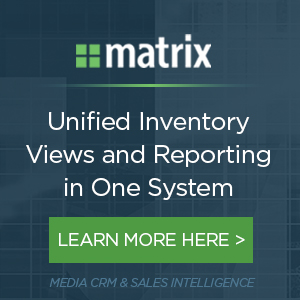Competition for Ad Dollars Is Not Who You Think

Sponsored Content by Matrix
Many broadcasters focus their ad sales efforts on surpassing their perceived competition, such as the cross-town rival in a local broadcast market or a new cable channel that is aimed at a similar audience. In reality, this isn’t the case: for most media companies, the largest source of competition for advertising dollars is from Google, Facebook, Amazon, and other social media and Internet properties. Consider a few statistics:
- New York-based market research firm eMarketer reported that TV ad spending in the USA totaled $71 billion in 2019.
- Also according to eMarketer, digital ad spending in 2020 totaled $139.8 billion for the U.S., which includes many different forms of advertising, such as banner ads, video ads and social media ads. The top three recipients of these ad dollars were Google, taking in $40 billion, Facebook, capturing $35 billon, and Amazon which garnered $14 billion.
- The Interactive Advertising Bureau reported on a survey conducted by Advertiser Perceptions to assess the intentions of larger advertisers and brands for spending in 2021. The survey found that 56% of video budgets are allocated to digital in 2021 as compared to 41% for traditional TV, including broadcast, cable and satellite. The survey also reported that digital video (which includes connected TV) is expected to enjoy double digit growth across all channels in 2021.

Broadcasters have good reasons to believe their inventory is more valuable than their digital competition. Television ads continue to have unassailable audience reach, particularly to populations that are not as active online, and they can be scheduled to reach consumers at home during leisure hours, when they have fewer other distractions. In contrast, most Internet usage happens at work during business hours. Broadcasters can also ensure that advertisers’ messages are not juxtaposed with unsafe or undesirable content. Plus, many studies have shown that ads on TV are more trusted by viewers than on other platforms.
Broadcasters do have barriers that make purchasing ads more difficult for buyers. Numerous local, as well as some national media companies, have inefficient internal ad sales processes, due to legacy systems and processes which compare unfavorably to the simple, quick sales transactions offered by online platforms. National marketers trying to place ads for a major TV campaign are confronted with markets that have multiple station groups and independent locals, many of which rely on disjointed sales and reporting systems. These difficulties are many times compounded by inconsistent metrics and reporting tools, making it difficult for advertisers to aggregate and analyze viewership data.
The sore point of lacking common metrics for reporting ad reach/effectiveness across media properties is detrimental for advertisers seeking a simplified ad buy. Although certain types of metrics are only available through interactive channels (such as click-through rates), broadcasters are unable to provide the data that they do have in a format that can be easily compared across multiple stations and markets. Although this improvement might, on the face of it, appear to increase competition between broadcasters, the reality is that traditional media companies are facing a much more significant threat from digital video advertising outlets on multiple facets. By teaming up and providing useful, granular data, broadcasters can help level the playing field against the digital ad giants in not only the ad sales process but in the post-sale attribution process helping to alleviate churn.
Broadcasters as a collective group can help expand the market for television advertisements by teaming up to define common currencies, ad sales platforms, and automated interfaces. By simplifying the ad sales process, broadcasters can reduce transaction costs without dipping into their revenue streams. Shared platforms would be particularly useful for advertisers with large budgets and a national footprint, but will also benefit smaller broadcasters and advertisers by making the TV ad sales process as easy as purchasing digital ads.
TV advertising continues to represent a unique and powerful way for marketers to reach large and diverse audiences. Unfortunately, current methods and systems used to buy and sell TV advertising tend to suffer from high levels of inefficiency, fragmentation and legacy solutions, putting media companies at a disadvantage relative to digital ad providers. These core and common issues have the potential to be rectified, though, if broadcasters can work together to identify the issues and simplify and streamline the ad sales process, making them even more attractive to today’s marketers.
Explore how you can begin to combat many of these issues by centralizing and leveraging all of your 1st and 3rd party ad sales data to optimize inventory. Read more.

About Matrix
Matrix Solutions is a forward-thinking technology company that empowers the media ad sales world with intelligence, technology, and expertise. It provides the technology back bone for the end-to-end workflow for sales organizations, transacting in the media marketplace. Its flagship solution, Monarch, is the only global ad sales platform built specifically for media, delivering the CRM and business intelligence necessary to optimize inventory, while the Matrix Sales Gateway, serving as a sell-side dedicated platform allows for the ingestion and dissemination of data from all providers in the ecosystem that participate in the negotiation and execution process. Matrix manages more than $13 billion annually in media ad revenue, has over 10K users, maintains over 95% renewal rate, and has founded the annual Media Ad Sales Summit and Media Ad Sales Council (MASC) – both of which bring together industry leaders to advance the future of media ad sales. For more information, please visit matrixformedia.com.
NEXT TV NEWSLETTER
The smarter way to stay on top of the streaming and OTT industry. Sign up below.
